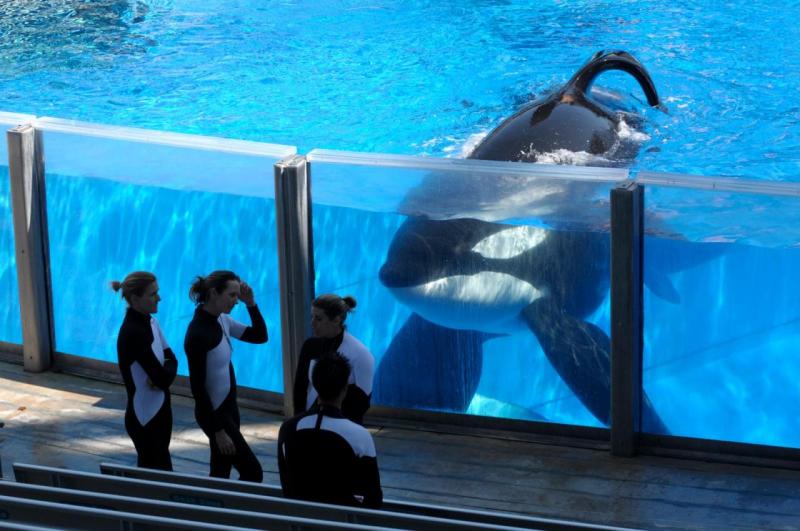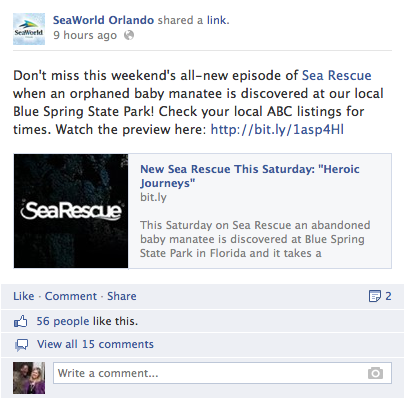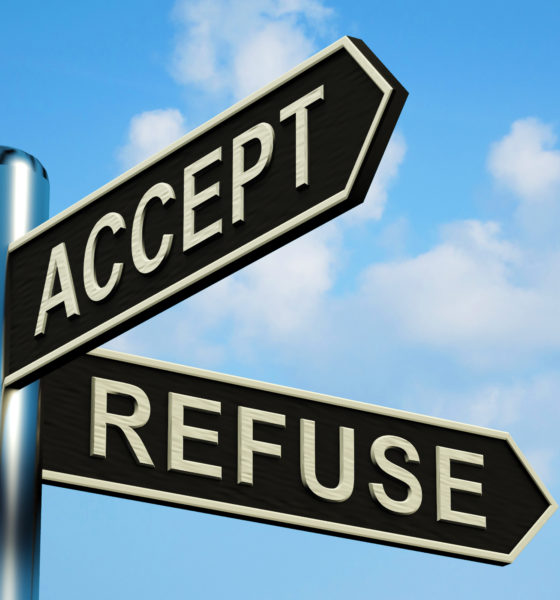
Becoming a Fan of “Blackfish”
Over the summer, I stumbled across the trailer for a new documentary called “Blackfish” about Tilikum, the killer whale responsible for the death of SeaWorld trainer Dawn Brancheau and two others. For no particular reason, I’ve never visited SeaWorld (either as a child or adult), and I’ve never been a “Save the Whales” kind of a gal. I knew nothing about this and had never paid much notice to killer whales. Yet something about the “Blackfish” trailer really drew my attention and I was fascinated. Watch it yourself:
[youtube height=”HEIGHT” width=”WIDTH”]http://www.youtube.com/watch?v=G93beiYiE74[/youtube]
I discovered the documentary would be coming to Atlanta this summer, but I couldn’t convince any family members to go see it with me. Same with my Facebook friends… people just didn’t want to drive to Midtown with me and pay to see a movie demonstrating animal cruelty; I couldn’t really blame them. I would have to wait to see “Blackfish” until it aired on CNN in October.

Tilikum and Dawn Brancheau
Image: blog.parrotearth.com
In the meantime, I read the amazing book “Death at SeaWorld” by David Kirby and was mesmerized, and have read quite a bit about this issue since then. I had no idea that killer whales were such incredibly intelligent and highly social beings. I’d also never comprehended that these truly magnificent creatures had no business whatsoever being held in captivity, and I was quickly swayed to the “anti-cap” viewpoint. I’m not going to use my blog to defend the merits of my previous statement and I don’t want to get into any arguments with the pro-SeaWorld crew. We’re going to have to agree to disagree folks, because I emphatically believe they don’t belong in captivity.
 For the uninitiated, one of the best online articles is “Killer in the Pool” by Tim Zimmermann, as well as his follow-up article “Blood in the Water,” about the death of trainer Alexis Martinez by Keto, a SeaWorld-owned killer whale at Loro Parque in the Canary Islands… exactly 2 months before the death of Brancheau. (These articles are a LOT shorter than Kirby’s book.) If you were as oblivious to this issue as I was prior to reading these articles, you’ll be astonished by the facts. There is something VERY wrong about keeping killer whales in captivity. I firmly believe these creatures (many of which are NOT good candidates to be released into the wild) should be retired to seapens which could be managed by SeaWorld, but would vastly improve the quality of life for the killer whales.
For the uninitiated, one of the best online articles is “Killer in the Pool” by Tim Zimmermann, as well as his follow-up article “Blood in the Water,” about the death of trainer Alexis Martinez by Keto, a SeaWorld-owned killer whale at Loro Parque in the Canary Islands… exactly 2 months before the death of Brancheau. (These articles are a LOT shorter than Kirby’s book.) If you were as oblivious to this issue as I was prior to reading these articles, you’ll be astonished by the facts. There is something VERY wrong about keeping killer whales in captivity. I firmly believe these creatures (many of which are NOT good candidates to be released into the wild) should be retired to seapens which could be managed by SeaWorld, but would vastly improve the quality of life for the killer whales.
SeaWorld Fights Back

Director Gabriela Cowperthwaite
Image: Zimbio
SeaWorld has diligently ignored “Blackfish” from the very beginning, like an annoying gnat at a picnic. Director Gabriela Cowperthwaite repeatedly tried to get SeaWorld’s side of the story when she developed “Blackfish” and was consistently rebuffed. It’s a shame, because according to the director, she didn’t set out to create an anti-SeaWorld film… she was just exploring the question of why would a killer whale kill its beloved trainer. She wanted this to be fair and balanced.
The fact that SeaWorld rejected her interview requests is really not surprising, given the misinformation SeaWorld has been feeding its paying customers over the years. Scenes evidencing this can be seen in “Blackfish”: watch as SeaWorld tour guides compare the frequency of dorsal fin collapse and killer whale mortality in captivity vs. in nature. (Shocker: SeaWorld presents itself as being the better option for the whales. Science tells us otherwise.) At the end of the documentary, Cowperthwaite includes a statement that SeaWorld refused to be interviewed by her.
 When “Blackfish” debuted at the Sundance Film Festival in February 2013, SeaWorld again tried to ignore this documentary. Many articles came out lauding the film and a conversation began in earnest about the ethics of keeping killer whales in captivity. However, it wasn’t until summer 2013 when “Blackfish” started appearing in movie theaters across the country, that SeaWorld finally made a rebuttal. It released the following statement with 8 points, arguing against the merits and truthfulness of “Blackfish” and the filmmakers responded. You can be the judge for yourself.
When “Blackfish” debuted at the Sundance Film Festival in February 2013, SeaWorld again tried to ignore this documentary. Many articles came out lauding the film and a conversation began in earnest about the ethics of keeping killer whales in captivity. However, it wasn’t until summer 2013 when “Blackfish” started appearing in movie theaters across the country, that SeaWorld finally made a rebuttal. It released the following statement with 8 points, arguing against the merits and truthfulness of “Blackfish” and the filmmakers responded. You can be the judge for yourself.
SeaWorld should have realized that “Blackfish” wasn’t a pesky gnat. It was more like the tiny but deadly mosquito that killed Taku, a 14-year-old killer whale in SeaWorld San Antonio in 2007, by giving it West Nile virus. Since airing on CNN, “Blackfish” is becoming deadly to SeaWorld’s mission and bottom line.
Blackfish Airs on CNN
On October 24, my wonderful husband volunteered to watch “Blackfish” with me and we were both amazed by what we saw. Cowperthwaite interviews many former trainers (Samantha Berg, John Hargrove, John Jett, Carol Ray and Jeffrey Ventre, to name a few), none of whom seem to have a personal axe to grind with SeaWorld, but all are now disillusioned by their own roles in perpetuating captivity. She also interviews John Crowe, who in the 1970s was hired to capture baby orcas, and who tells us, “I felt like I was kidnapping a little kid from his mother…. This is the worst thing I have ever done.”

Image: CNN
The story was told repeatedly about how SeaWorld routinely separated killer whales from their families, both during the capture process and once they were being held in captivity, moving whales from one park to another like oversized chess pieces. I simply couldn’t help comparing this to the way Americans treated slaves in the early days of our country. It’s heartless and cruel. During the film, my husband was especially bothered when the staff at Sealand of the Pacific (Tilikum’s first marine park) explained how they withheld food from the killer whales, to incentivize them to perform or go inside their horrific night-time sleeping quarters.
I’ve watched the documentary twice more since it originally aired. I can’t recommend it enough… while it’s disturbing, there’s really nothing young kids couldn’t see. (The possible exception is the scene where they demonstrate SeaWorld’s “husbandry” methods to get Tilikum to provide sperm for their breeding program.)
Tsk, Tsk SeaWorld
The effect on social media since “Blackfish” aired on October 24 has been astounding. I’m not going to summarize all that’s happened since this article does a beautiful job describing it. But of course, my eye was drawn to the statement that SeaWorld is deleting comments from people on their Facebook page.
Truly, I feel like we’re living through the Hobby Lobby debacle all over again. To their credit, Hobby Lobby never closed its Facebook page to comments from fans (the “Posts From Others” section), but SeaWorld has done so. Apparently, there are countless number of complaints from Facebook users, and rather than respond politely (as Hobby Lobby eventually did), they’ve just deleted the comments once and for all. So, the resourceful fans are responding to ANY post they see. Here’s the proof:
 If you look at this post, obviously there are 15 comments on this post. However, if you click on “View all 15 comments,” here is what you’ll see:
If you look at this post, obviously there are 15 comments on this post. However, if you click on “View all 15 comments,” here is what you’ll see:
 That’s right, you only see 2 comments. Where are the remaining 13 comments? Obviously, SeaWorld didn’t like these comments and has deleted them. They also want everything to be all kittens and rainbows at SeaWorld’s Facebook page. As an experiment, I posted this comment on the bottom of this post, just to see if SeaWorld would delete the comment or even ban me.
That’s right, you only see 2 comments. Where are the remaining 13 comments? Obviously, SeaWorld didn’t like these comments and has deleted them. They also want everything to be all kittens and rainbows at SeaWorld’s Facebook page. As an experiment, I posted this comment on the bottom of this post, just to see if SeaWorld would delete the comment or even ban me.
 It sounds like they are banning people, but hey, I was willing to try this in the name of social media. Sure enough, less than 45 minutes later, my comment was deleted (although I wasn’t banned).
It sounds like they are banning people, but hey, I was willing to try this in the name of social media. Sure enough, less than 45 minutes later, my comment was deleted (although I wasn’t banned).
Here’s a fascinating article from the team over at The Orca Project, about how they were banned and then protested in 2010. SeaWorld did respond, but I love this phrase: “This is a SeaWorld fan site. You can say what you please where you please, but we are under no obligation to provide you with a forum that you then use to criticize us.”
All I can say is: SeaWorld, you guys should take a page from Hobby Lobby. You are getting bad social media advice from somebody. If you want your fanbase to remain loyal and energized, then you need to stop banning and deleting anything you deem even remotely negative, and allow the natural flow of conversation to happen. The brouhaha about Hobby Lobby has died down because they handled it appropriately. Your arrogance in rejecting any and all criticism is showing, but it’s hardly the first time. For the sake of the whales, I hope some of your pardigms are soon shifted.







sofeisty
November 2, 2013Please allow them to self destruct. Hopefully no social media experts will help or rescue them. THEY ARE NOT THE ONES WHO NEED TO BE SAVED.
ProjectSocial
November 2, 2013Hey Sofeisty, I understand what you’re saying. I’m not looking to see SW self-destruct, but I think the free flow of conversation on social media (including their FB page) could only be a good thing for the anti-cap movement… which is clearly why they are deleting and banning. Somehow, I think it’s really unlikely that SW is going to read my blog post and take my advice. 🙂
Maria
November 2, 2013Hopefully they read your post as I sent it to their FB inboxes 🙂
ProjectSocial
November 4, 2013Haha, thanks Maria. I will keep an eye on their page to see if this kind of thing continues to happen.
Maria
November 2, 2013Great blog post. Thank you. I too was deleted from all of their pages, including the Miami Seaquarium that houses Lolita. I still sent them messages though. I got a response from Sea World Australia who confirmed that they DO NOT keep Orcas and support their release. The media attention re: Blackfish is AMAZING and I am counting down the days until SeaWorld must come out and admit they are wrong.
ProjectSocial
November 2, 2013Maria, it’s nice to be in such good company (“the deleted from SW”). Oh dear, Miami Seaquarium is doing it too? Interesting that SW Australia has such a different policy. We can celebrate together when SW admits they are wrong, but I don’t expect it any time soon, unfortunately.
Emily Marj
November 3, 2013Sea World Australia have a different policy as they are a completely different corporate entity to SeaWorld Parks and Entertainment (US) & they are owned by different groups. I think they’re doing as best they can to distance themselves from the anti-seaworld message, it was sort of unfortunate that they shared the same name. I still don’t agree with them keeping captive dolphins, but I’m glad they’re at least attempting to handle the situation.
ProjectSocial
November 4, 2013Emily, it’s kind of hard to blame SW Australia for distancing themselves, isn’t it? 🙂